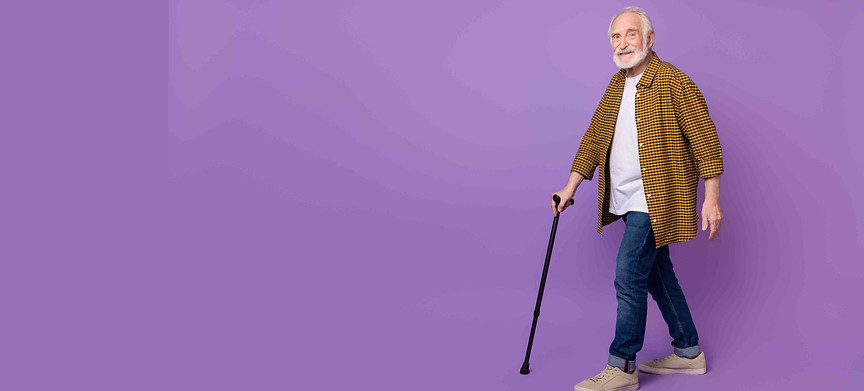Trips and Falls Treatment

Those aged over 65 are the most likely group to experience a trip or fall.
A third of adults aged over 65 and half those aged over 80 experience a fall at least once a year.
The fall is more likely to cause a serious injury the older you are or if you have conditions such as Osteoperosis, which means your bones are more likely to break if you fall.

How can we avoid falls?
Falls often occur due to balance issues or weaknesses. As we get older our muscles generally become weaker and as a result our balance becomes poorer. This makes uneven ground more challenging often resulting in falls.
As we become weaker we can't lift our legs as high, so we trip on objects, such as a pavement curb or uneven pavement slabs.
One way to improve this is to improve the strength of our muscles. For some time Sports Scientists have been researching strength training in older adults.
One thing that is becoming increasingly clear, is that strength training is essential to maintain mobility as we age. The body can certainly adapt to exercise at any age, though it does take a little longer as you get into your 70's.
Balance can be trained easily through classes such as Thai Chi, Body Balance or simple home based exercises.

Should I use a stick?
You, the doctor or the family, in an act of good intent, decide a stick will give more security and here a new problem can emerge. Using a stick changes our balance senses, we are now walking with three points of contact, not two.
This works until the stick is abandoned, possibly just for a few seconds to open a door or step over a threshold, at his point there is now an increasing likelihood that loss of balance and a fall will occur.
When used for support, a stick tends to be used in front of the body rather than the side and this leads to a forward lean, which over time can become fixed stoop. This stoop moves the centre of gravity forward of our centre of mass, which significantly increases the likelihood of tripping or loss of balance.
That same forward lean also compresses the ribs together, giving rise to a multitude of issues related to a limited ability to deep breath. The direct results of this include reduced fitness, resulting in reduced distance walked, resulting in less leg strength, making falls more likely, recurring chest infection and quite a few others.
It can be very easy to become stuck in this cycle without being aware that this is happening, or assuming it is due to other causes.
However, don't abandon your stick at this point. Not without seeking to address, understand and correct the issues that lead to using a stick in the first place. If you are used to a stick, you will have reset your movement and balance pattern to stick use. A careful weening off of a stick is necessary, whilst addressing the background causes.
We can help with this is you would like to stop using your stick. We can gently retrain your centre of balance using simple at home exercises until you don't need the stick any more.

What exercises can I do to help with trips and falls?
Here are some exercises that can improve balance
1) Walk very very slowly, walking slowly as an exercise in a safe space where you cant fall is extremely effective. In everyday walking we only load the feet for a couple of seconds and we are used to this. However, by slowing down we load our feet for longer and this has the effect of strengthening them, as it is an unfamiliar way of loading the feet.
2) Do a slow walk with and without shoes. The slow walk also works the proprioceptors in the feet. Thats the nerves that allow our brain to work out where our body is in relation to our feet. doing this with shoes, means we develop the proprioception we will use when walking outside and doing without shoes, means we work the proprioception we will use when we first get out of bed but don't have slippers on yet.
3) Tai Chi. One of the main elements of Tia Chi is slow controlled movement and just as highlighted in point 2, this helps both strength and proprioception, But with Tia Chi the movements are wide and varied, so it works strength and balance in unfamiliar positions.
Having strength and balance in lots of positions, other than walking and standing straight, means less chance of losing our balance and falling if we find ourselves in an unfamiliar position.
Thai Chi classes are great but they don't suit everybody, your mobility may not allow you to get out of the house or stay on your feet for long enough.
Don't worry, There are plenty of home videos and here at The Reinge Clinic we an adapt Tai Chi specifically to your situation and give you an individual home programme to match your needs.
4) Observe your own walking and ask yourself:
1) Do you drag your feet? This may be due to lack of energy or strength.
2) Do you scuff your feet? This is often associated with reduced ability to lift your legs easily.
3) Do you take very short steps? This can be lack of strength whilst loading the supporting leg or a lack of balance.
4) Do your feet point forward, outwards or do they point in slightly different directions? This is often related to the actual strength of your feet and their ability to support themselves. If your feet point anything other than forward it can be a real trip hazard.
All of the above are of course completely correctable with simple but correctly targeted physiotherapy and exercise interventions.




